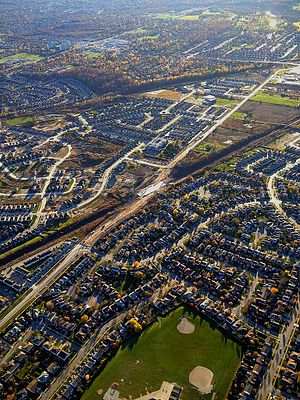 |
| English: Urban Sprawl in London, Ontario (Photo credit: Wikipedia) |
Today we review a literature review of articles that examine the meaning of urban sprawl globally, its impacts on air, water, land and energy, how it relates to justice and equity and how different countries either encourage or discourage its growth. The authors point out that, although sprawl has no widely accepted definition, improvement comes when it is viewed within the context of urban sustainability rather than narrowly as a geographic metric.
Key Quotes:
“At its core, urban sprawl is a complex and multifaceted phenomenon with no universally accepted definition.. In the Western context the term typically evokes images of low density, automobile dependent, and largely monotonous residential development along the periphery of an urban area”
“compact development can significantly reduce pollutant emissions at the regional scale, but only over the long-term and when complemented with growth controls, disincentives for vehicle use, and technological emissions controls.”
“The consumption of fossil fuels is the largest contributor to CO2 emissions followed by land use change ..and these are the primary connections between urban sprawl and climate change observable in the planning literature.”
“Within the buildings sector, the connection between urban sprawl and climate change hinges on energy losses through transmission lines (i.e., longer distances spanned), larger heated areas on average, and increased surface temperatures by virtue of the heat island effect in areas with more sprawl”
“Conceptualising urban sprawl as a pattern of development unfolding over time that is incompatible with commonly accepted characteristics of sustainable development can potentially alleviate many of the difficulties that have plagued sprawl research”
“Economic and social dimensions of sustainable development are as important as environmental considerations and the true challenge for those who inhabit, manage, and study urban area is to somehow balance these three aspects.”








No comments:
Post a Comment